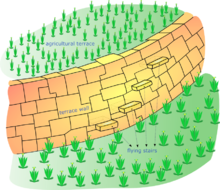Terrace (earthworks)
This article needs additional citations for verification. (October 2013) |

In agriculture, a terrace is a piece of sloped plane that has been cut into a series of successively receding flat surfaces or platforms, which resemble steps, for the purposes of more effective farming . This type of landscaping, therefore, is called terracing. Graduated terrace steps are commonly used to farm on hilly or mountainous terrain. Terraced fields decrease both erosion and surface runoff, and may be used to support growing crops that require irrigation, such as rice. The rice terraces of the Philippine Cordilleras have been designated as a UNESCO World Heritage Site because of the significance of this technique.[1]
Terraced paddy fields are used widely in rice, wheat and barley farming in east, south, and southeast Asia, as well as other places. Drier-climate terrace farming is common throughout the Mediterranean Basin, e.g., in Cadaqués, Catalonia, where they were used for vineyards, olive trees, cork oak, etc., on Mallorca, and in Cinque Terre, Italy.
In the South American Andes, farmers have used terraces, known as andenes, for over a thousand years to farm potatoes, maize, and other native crops. Terraced farming was developed by the Wari' and other peoples of the south-central Andes before 1000 AD, centuries before they were used by the Inca, who adopted them. The terraces were built to make the most efficient use of shallow soil and to enable irrigation of crops.
The Inca built on these, developing a system of canals, aqueducts, and puquios to direct water through dry land and increase fertility levels and growth.[2] These terraced farms are found wherever mountain villages have existed in the Andes. They provided the food necessary to support the populations of great Inca cities and religious centres such as Machu Picchu.
Terracing is also used for sloping terrain; the Hanging Gardens of Babylon may have been built on an artificial mountain with stepped terraces, such as those on a ziggurat.[citation needed] At the seaside Villa of the Papyri in Herculaneum, the villa gardens of Julius Caesar's father-in-law were designed in terraces to give pleasant and varied views of the Bay of Naples.
Terraced fields are common in islands with steep slopes. The Canary Islands present a complex system of terraces covering the landscape from the coastal irrigated plantations to the dry fields in the highlands. These terraces, which are named cadenas (chains), are built with stone walls of skillful design, which include attached stairs and channels.[citation needed]
In Old English, a terrace was also called a "lynch" (lynchet). An example of an ancient Lynch Mill is in Lyme Regis. The water is directed from a river by a duct along a terrace. This set-up was used in steep hilly areas in the UK.[citation needed]
Gallery
-
Tetang Village terraced fields, Mustang District
-
Terraced field in Kabal Swat valley
-
Terraced farmland in Peru, adopted by the Inca.
-
Terraced hay fields in the Upper Mississippi River basin during the 1930s.
-
Jatiluwih rice terrace in Bali, Indonesia.
-
The Banaue Rice Terraces in Ifugao, Philippines.
-
Rice cultivation, Lower Himalayas, Nepal.
-
Terraced fields in Sa Pa, Vietnam.
-
Longsheng Rice Terrace in Longsheng county, Guangxi Province, southern China.
-
Abstract pattern of terraced rice fields in Yuanyang County, Yunnan, China
-
Image from Yuanyang, showing the rice terrace walls after harvest, weed removal, flooding and plowing.
-
Terrace fields in Northern Thailand at the end of the dry season
-
Rice terrace in Bali
-
Terraced fields in the Upper Mustang region of Nepal
See also
References
- ^ "World Heritage List". UNESCO. Retrieved 2012-09-22.
- ^ "Farming Like the Incas". Smithsonian Magazine. Retrieved 2015-09-20.














